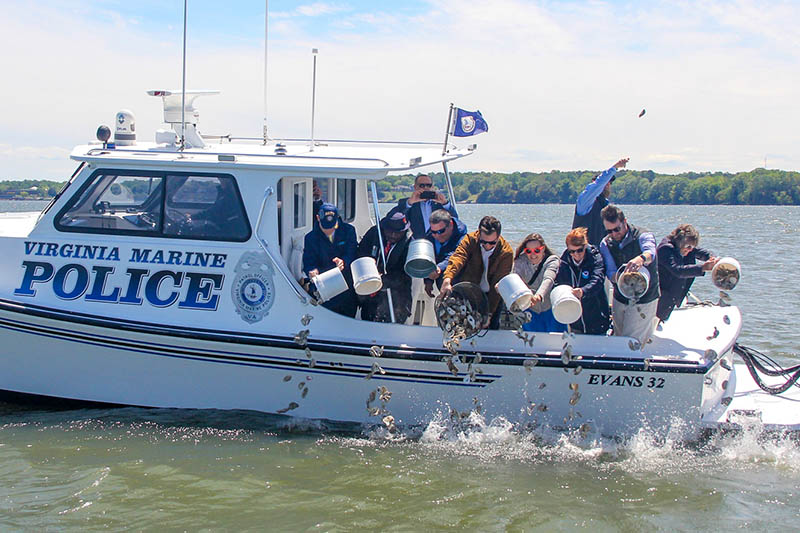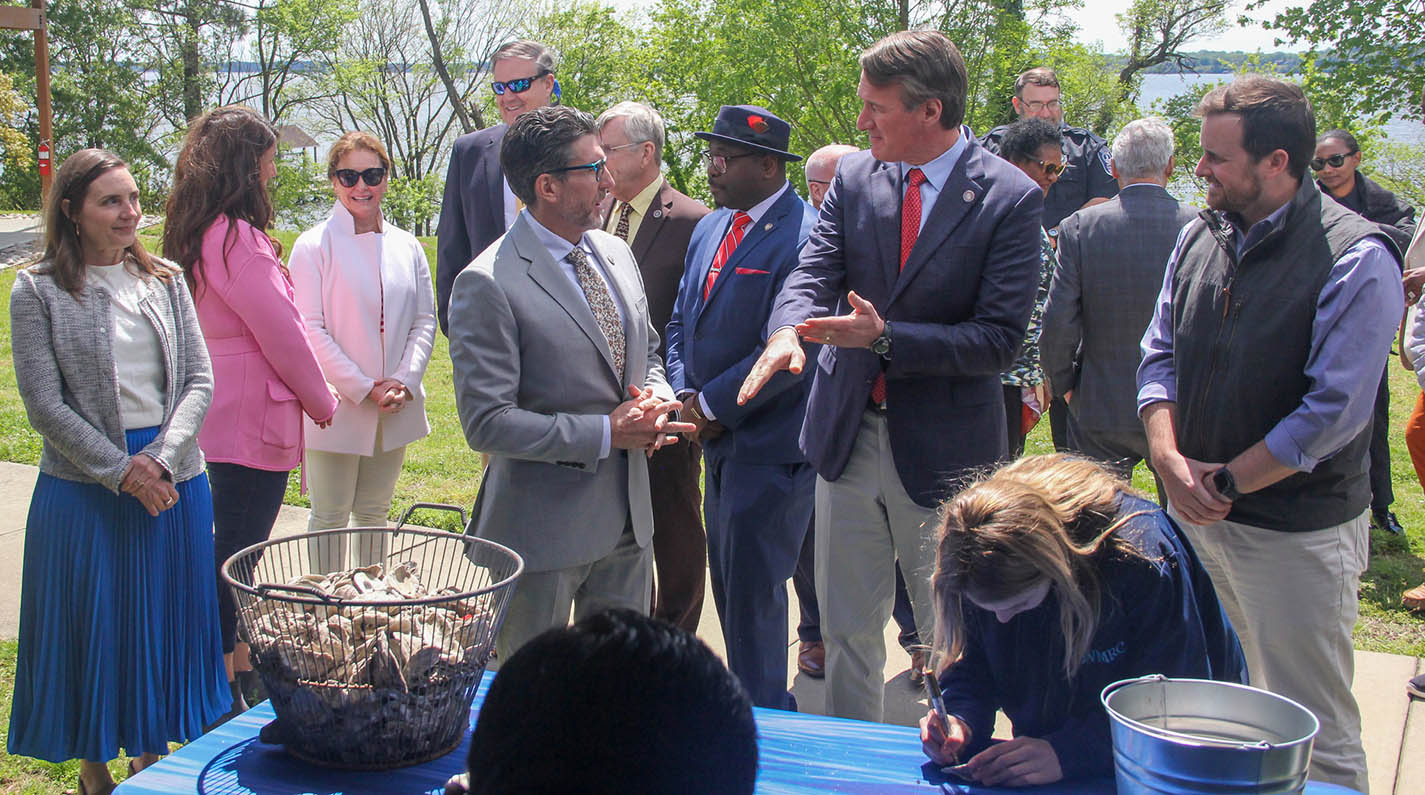Virginia celebrates key oyster restoration milestone in the York River
On Monday, Governor Glenn Youngkin joined representatives from the Virginia Marine Resources Commission (VMRC) and the National Oceanic and Atmospheric Administration (NOAA) at William & Mary’s Virginia Institute of Marine Science to celebrate the achievement of the Chesapeake Bay Oyster Restoration Goal for the York River. The event marked a significant milestone in Maryland and Virginia’s ongoing partnership in the Chesapeake Bay Watershed Agreement to rejuvenate oyster populations in the Bay.
“VIMS scientists were instrumental in developing the idea of tributary-level oyster restoration, which was ultimately adopted by the Chesapeake Bay Watershed Agreement,” said Derek Aday, director of Virginia Institute of Marine Science and dean of William & Mary’s School of Marine Science, during his opening remarks. “Fundamental science to support the restoration effort from both ecological and commercial perspectives originated right here.”
Gathering on a lawn at VIMS overlooking the York River, the partners reflected on the milestone and the importance of maintaining a healthy Bay for all who depend on it for business and pleasure.
“Through our good work to improve water quality, Virginia’s oyster populations are at a 40-year high. We have the largest public replenishment program in the nation, and maybe the world,” said Youngkin, acknowledging the completion of the York River restoration goal. “These public-private partnerships work. Science-based management strategies work. And when we commit ourselves, we can make a difference.”
At the conclusion of the main event, Governor Youngkin and others signed their names on oyster shells before sampling oysters from several of Virginia’s oyster farms. Virginia’s Departments of Wildlife Resources, Environmental Quality and Conservation and Recreation were also present, handing out informational materials about their work.
 Then, representatives from VMRC, NOAA, VIMS and Governor Youngkin’s administration boarded VMRC vessels at VIMS’ Boat Basin and headed out to one of the restoration sites on the York River to symbolically scatter the signed oysters over the reef to signify completion of the project.
Then, representatives from VMRC, NOAA, VIMS and Governor Youngkin’s administration boarded VMRC vessels at VIMS’ Boat Basin and headed out to one of the restoration sites on the York River to symbolically scatter the signed oysters over the reef to signify completion of the project.
The 2014 Chesapeake Bay Watershed Agreement established a 2025 deadline for the restoration of oyster habitats in 10 Chesapeake Bay tributaries in Maryland and Virginia. The restoration work is led by VMRC, with support and funding provided by NOAA.
The York River, one of five Virginia tributaries identified in the agreement, included over 200 acres of substrate planting, which creates natural habitat for the seeding of oysters. According to VMRC officials, more than 1 million bushels of oyster shells and granite were used as substrate. Similar efforts in the other tributaries identified in the Chesapeake Bay Watershed Agreement are nearing completion.
Restoration informed by science at VIMS
In the late 19th and early 20th centuries, oyster reefs in the Chesapeake Bay were so abundant that ships had to navigate around them. However, their population in the 20th century plummeted due to overfishing and disease, culminating in a near collapse of the fishery in the late 1990s.
VIMS has played a pivotal role in the recovery of oyster and other shellfish populations in the Chesapeake Bay, which has significant ecological and commercial benefits for the region. VIMS’ Shellfish Aquaculture Program originated at its Eastern Shore Lab (ESL), with an initial focus on clams. Mark Luckenbach, associate dean of research and advisory services at VIMS, became director of the ESL in 1989. Not long after, he established VIMS’ oyster aquaculture efforts.
“At the time, around 80-90% of the oysters on many oyster reefs in the Bay were dying from disease. I grew up on a cattle ranch in South Texas, so, naturally, I tapped into some ongoing efforts at VIMS by Dr. Gene Burreson to breed disease resistant oysters and started working on ways to farm them in intensive aquaculture. That was the start of VIMS’ oyster aquaculture efforts,” said Luckenbach.
Virginia’s oyster restoration efforts in the early 1990s involved scattering shells on the bottom of the Bay. Since oysters attach to each other in the wild to form large reefs, this has the effect of facilitating the seeding of wild larvae. However, these efforts were negated by oyster harvesting.
“The put and take approach wasn’t working well,” said Luckenbach. Annual oyster fishing yields were steadily declining, and the overfishing coupled with increasingly virulent diseases led to a crash in wild oyster populations in the Bay.
To help enhance resistance to the primary diseases affecting oysters, VIMS established its Aquaculture Genetics and Breeding Technology Center (ABC). Now led by VIMS Assistant Professor Jessica Small, ABC uses a combination of selective breeding and genetics research to improve the traits of the native eastern oyster. Its work has helped revitalize and improve the economic value of oysters in the Bay and encouraged rapid growth of the local oyster aquaculture industry.
In 1995, Luckenbach and fellow scientists held a two-day symposium focusing on the Bay’s oyster population, inviting ecologists and fisheries managers to participate. This unique ecological and commercial partnership helped establish scientific studies that led to a tributary approach to reef restoration on a scale that had never been tried before.
Eventually, this work helped establish the goals laid out in the 2014 Chesapeake Bay Watershed Agreement between Virginia and Maryland. With restoration work in the York River now completed and other tributaries not far behind, the states are on track to meet their 2025 goal.
Today, thanks to improved fisheries management, extensive disease surveillance led by VIMS Professor Ryan Carnegie, selective breeding of disease-resistant oysters, and habitat restoration, oyster populations in the Bay are experiencing a significant rebound. With continued partnerships focusing on ecological and commercial sustainability, VIMS is dedicated to continued restoration of shellfish populations in Virginia and North America.


